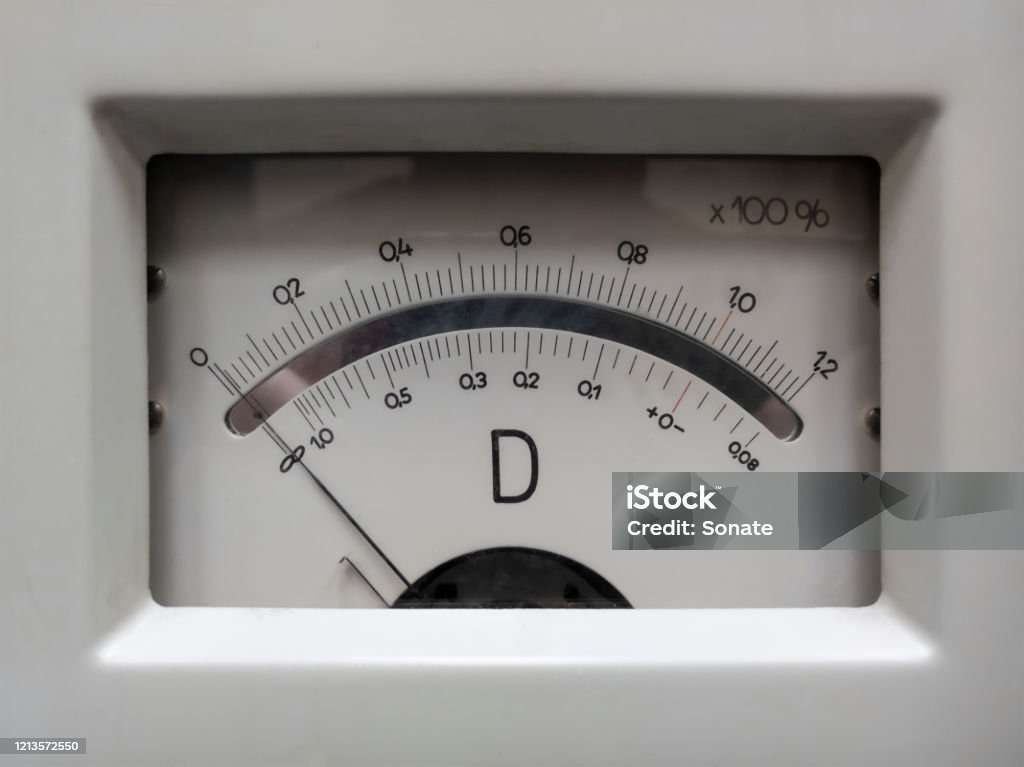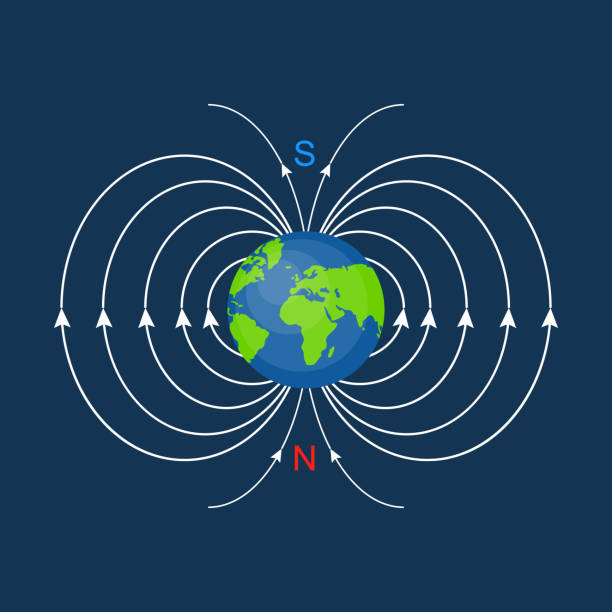A sensitive device called a moving coil galvanometer is used to measure tiny electric currents. It functions according to the idea that a current-carrying coil rotates when it encounters a torque in a magnetic field. The device can detect and quantify small currents with high precision since this rotation is proportional to the current passing through the coil.
Principle of Moving Coil Galvanometer
Working principle of a moving coil galvanometer is based on the creation of mechanical force by the interaction of a magnetic field and a current-carrying conductor. A coil of wire in a magnetic field rotates when an electric current flows through it, creating torque in the coil.
The coil’s rotational angle is directly proportional to the amount of current flowing through it. When the coil rotates, a counter-torque supplied by a spring or restoring mechanism equalizes the magnetic torque. A pointer affixed to the coil indicates the amount of spin, which is proportionate to the current, enabling the galvanometer to precisely detect tiny electric currents..
Construction Moving Coil Galvanometer
Following are the parts of moving coil Galvanometer:-
1. Magnetic Field: A permanent magnet, which is typically shaped like a horseshoe or cylindrical, produces a strong magnetic field. The purpose of the magnetic poles is to create a radial, homogeneous magnetic field inside the space created by the air between them.
2. Coil: A permanent magnet, which is typically shaped like a horseshoe or cylindrical, produces a strong magnetic field. The purpose of the magnetic poles is to create a radial, homogeneous magnetic field inside the space created by the air between them.
3. Suspension System: Usually composed of phosphor bronze, a thin conducting strip or torsion wire is used to support the coil in the magnetic field. The suspension wire’s lower end is connected to a fine spiral spring that supplies the required restoring torque, while the upper end is fixed to a rigid support.
4. Soft Iron Core: An iron cylinder made of soft iron is inserted within the coil to increase sensitivity and produce a magnetic field that is radial. A soft iron core guarantees that the coil experiences the highest torque for a given current and raises the magnetic flux density.
5. Pointer and Scale: The coil is fitted with a lightweight pointer that moves around a calibrated scale. The deflection, which reflects the current flowing through the coil, is indicated by the pointer. Frequently, the scale is indicated in a way that makes it simple to interpret the data in terms of current.
6. Damping Mechanism: The galvanometer has a damping mechanism, which typically uses air or eddy current damping, to ensure rapid and constant deflection without oscillations. After the coil has been deflected by a current, this damping device aids in its rapid return to rest.

Working Moving Coil Galvanometer
The electromagnetic induction principle, which states that a current-carrying conductor placed in a magnetic field experiences a force, is the foundation for the operation of a moving coil galvanometer.
Current Flow Through the Coil: A magnetic field is created around the galvanometer’s coil as an electric current passes through it. A permanent magnet’s coil, which is suspended between its poles, interacts with the magnet’s external magnetic field.
Torque on the Coil: A torque is applied to the coil as a result of the interaction between the magnetic field created by the coil’s current and the surrounding magnetic field. The following formula provides this torque:.
Τ = n⋅B⋅I⋅A⋅sin(θ)
where:
τ is the torque on the coil,
n is the number of turns in the coil,
B is the magnetic flux density,
I is the current flowing through the coil,
A is the area of the coil, and
θ is the angle between the magnetic field and the normal to the coil.
Restoring Torque: The suspension wire or spring that the coil is attached to produces a restoring torque when the coil turns. As the angle of deflection rises, this restoring torque grows in opposition to the magnetic torque. This yields the restoring torque:
τr = k⋅θ
where:
τr is the restoring torque,
k is the torsional constant of the suspension wire, and
θ is the angle of deflection of the coil.
Equilibrium Position: Until the restoring torque and the magnetic torque are equal, the coil keeps rotating. The coil comes to rest at this equilibrium position, and the coil’s associated pointer shows a deflection on the calibrated scale. The galvanometer measures the current because this deflection is directly proportional to the current flowing through the coil.
Coil Rotation: The coil rotates due to the torque. The force acting on a current-carrying conductor in a magnetic field is perpendicular to both the current and the magnetic field, according to Fleming’s left-hand rule, which guides the direction of this rotation.
Damping Mechanism: A damping mechanism is frequently used to guarantee that oscillations are avoided and that the coil comes to rest promptly. Accurate readings and coil stabilization are frequently achieved by the use of air damping or eddy current damping.
Reading the Measurement: The pointer’s final deflection reflects how much current is passing through the coil. Typically, the scale is indicated in divisions or units of current, making it simple for consumers to understand the measurement..
Advantages and Disadvantages of a Moving Coil Galvanometer:-
Advantages:-
High Sensitivity: The moving coil galvanometer is perfect for picking up minute electrical signals because of its high sensitivity to tiny electric currents.
Linear Scale: In a moving coil galvanometer, the current passing through the coil immediately correlates with the deflection of the needle. This linearity increases measurement accuracy and facilitates reading interpretation.
High Accuracy: Because of its sensitive mechanism and the homogenous magnetic field in which the coil moves, the device offers extremely accurate measurements. In laboratory tests and scientific research, this accuracy is crucial..
Low Power Consumption: The moving coil galvanometer’s great sensitivity means that it uses very little power to function, which is advantageous in circuits where power conservation is crucial.
Damping Control: When a galvanometer is built with the right damping (either air or eddy current damping), the pointer can swiftly come to rest without experiencing undue oscillation. This guarantees more consistent outcomes and quicker readings.
Disadvantages:-
Fragility: The moving coil galvanometer is brittle and prone to damage due to its delicate construction, which includes a fine wire coil and a sensitive suspension mechanism.
Limited Range: Galvanometers with moving coils are only intended to measure very tiny currents. They cannot withstand high voltages or currents without suffering harm.
Temperature Sensitivity: Temperature variations can have an impact on the accuracy of a moving coil galvanometer. Temperature variations might cause measurement inaccuracies because of the coil’s resistance and the suspension wire’s ability to expand or shrink..
Zero Error: The pointer’s zero position may change due to stretching or deformation of the spring or suspension system over time. To keep accurate measurements, this zero error needs to be verified and adjusted on a frequent basis.
Not Suitable for AC Measurements: The moving coil galvanometer is mainly intended for measurements of direct current (DC) and is not sensitive to alternating currents (AC) since the AC produces torque that changes quickly in one direction and eventually averages zero..
Sensitivity moving coil galvanometer
Factors Affecting Sensitivity:-
1. Number of Turns (N): A moving coil galvanometer’s sensitivity rises as the coil’s number of turns increases. More turns translate into more torque for the same amount of current, which raises sensitivity.
2. Damping: Damping must be done correctly for sensitivity. The coil may not deflect sufficiently if the damping is set too high, which would lower sensitivity. However, insufficient damping can lead to coil oscillation, which makes it challenging to get precise readings.
3. Magnetic Field Strength (B): A stronger magnetic field increases the galvanometer’s sensitivity. The strength of the magnetic field the coil is situated in directly relates to the torque applied to it.
4. Area of the Coil (A): The area of the coil directly relates to sensitivity. Greater deflection for a given current is produced by a larger coil area because it increases the magnetic flux linkage.

Note:-
Enhancing Sensitivity
Normally, following design factors are taken into account in order to enhance the sensitivity of a moving coil galvanometer:
• Make use of a coil with a lot of turns.
• Set up a strong, even magnetic field for the coil.
• Verify the coil’s vast surface area.
A suspension wire with a low torsional constant should be used.
• Optimize damping to prevent overshooting and enable rapid, stable deflection.
Moving coil galvanometer is an instrument used to detect and measure small quantity of electric currents. It operates on the principle that a current-carrying coil in a magnetic field experiences a torque. The primary use of a moving coil galvanometer is to measure small DC currents with high sensitivity and accuracy in laboratory.
Moving coil galvanometer works by placing a current-carrying coil within a magnetic field. When current flows through the coil, it experiences a torque due to the magnetic interaction, causing the coil to rotate. The rotation of the coil moves a pointer across a calibrated scale, indicating the magnitude of the current. The amount of deflection is directly proportional to the current passing through the coil.
Sensitivity of a moving coil galvanometer is affected by following factors:-
- Number of turns in the coil,
- Strength of the magnetic field,
- Area of the coil,
- Torsional constant of the suspension wire.
Moving coil galvanometer is not suitable for measuring Alternating Current (AC) because it is designed to respond to the unidirectional torque produced by Direct Current (DC). In AC, the current direction changes rapidly, causing the torque to alternate direction as well. This results in the coil experiencing forces in opposite directions in quick succession, leading to an average deflection of zero, making it ineffective for AC measurements.
Common limitations of a moving coil galvanometer are:-
Fragility:- As it can be easily damaged by mechanical shock or excessive currents.
It is also limited to measuring small DC currents and cannot handle large currents or voltages without additional components.
Its accuracy can be affected by temperature variations, which can change the resistance of the coil and the tension of the suspension wire. Regular calibration is needed to maintain precise measurements.